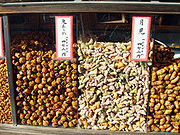
Arare
Encyclopedia


Japanese cuisine
Japanese cuisine has developed over the centuries as a result of many political and social changes throughout Japan. The cuisine eventually changed with the advent of the Medieval age which ushered in a shedding of elitism with the age of shogun rule...
cracker
Cracker (food)
A cracker is a baked good commonly made from grain flour dough and typically made in quantity in various hand-sized or smaller shapes. Flavorings or seasonings, such as salt, herbs, seeds, and/or cheese, may be added to the dough or sprinkled on top before baking...
made from glutinous rice
Glutinous rice
Glutinous rice is a type of short-grained Asian rice that is especially sticky when cooked. It is called glutinous Glutinous rice (Oryza sativa var. glutinosa or Oryza glutinosa; also called sticky rice, sweet rice, waxy rice, botan rice, biroin chal, mochi rice, and pearl rice, and pulut) is a...
and flavored with soy sauce
Soy sauce
Soy sauce is a condiment produced by fermenting soybeans with Aspergillus oryzae or Aspergillus sojae molds, along with water and salt...
. The size and shapes are what distinguish arare from senbei
Senbei
are a type of Japanese rice crackers. They come in various shapes, sizes, and flavors, usually savory but sometimes sweet. Senbei are often eaten with green tea as a casual snack and offered to visiting house guests as a courtesy refreshment....
. The name is chosen to evoke snow pellets – smaller arare are similar in size and shape to snow pellets, though others can vary significantly in size, flavour and shape.
Types
There are many different sizes, colors, and shapes of arare. Some are sweet, and others savory. One, called norimaki arare (nori meaning an edible seaweed in the form of a dried sheet; maki meaning roll shape) is wrapped with dried noriNori
is the Japanese name for various edible seaweed species of the red alga Porphyra including most notably P. yezoensis and P. tenera, sometimes called laver. Finished products are made by a shredding and rack-drying process that resembles papermaking...
seaweed. Another, , takes its name from its resemblance to a persimmon
Persimmon
A persimmon is the edible fruit of a number of species of trees in the genus Diospyros in the ebony wood family . The word Diospyros means "the fire of Zeus" in ancient Greek. As a tree, it is a perennial plant...
seed. (Kaki is Japanese for "persimmon".) Kaki no tane are often sold with peanuts, a combination called . These are a popular snack to accompany Japanese beer
Japanese beer
Beer in Japan had its start in the 17th century during the Edo Period when the Dutch opened a beer hall for sailors working the trade route between Japan and the Dutch Empire...
.
Culture
Japanese typically consume arare to celebrate the Doll FestivalHinamatsuri
The Japanese , or Girls' Day, is held on March 3. Platforms covered with a red carpet are used to display a set of representing the Emperor, Empress, attendants, and musicians in traditional court dress of the Heian period.- Origin and customs :...
(Hinamatsuri), on March 3, Girls' Day in Japan. The arare made during the festival are very colorful - pink, yellow, white, brown, light green, and so on. Regular arare can be bought throughout the year, but the colorful ones are only available around January to March in anticipation of the Doll Festival.
Arare was brought to the U.S.
United States
The United States of America is a federal constitutional republic comprising fifty states and a federal district...
by Japanese immigrants
Japanese in Hawaii
The Japanese in Hawaii simply Japanese or “Local Japanese”, rarely Kepanī are the second largest ethnic group in Hawaii. At their height in 1920, they constituted 43% of Hawaii's population. They now number about 16.7% of the islands' population, according to the 2000 U.S...
who came as plantation workers in the early 1900s. In Hawaii
Hawaii
Hawaii is the newest of the 50 U.S. states , and is the only U.S. state made up entirely of islands. It is the northernmost island group in Polynesia, occupying most of an archipelago in the central Pacific Ocean, southwest of the continental United States, southeast of Japan, and northeast of...
, the snack is often called kakimochi (fried rice paste) or mochi crunch. In Hawaii, it is popular to mix arare with popcorn (some people mix in furikake
Furikake
is a dry Japanese condiment meant to be sprinkled on top of rice. It typically consists of a mixture of dried and ground fish, sesame seeds, chopped seaweed, sugar, salt, and monosodium glutamate...
, too). The popular Hurricane popcorn includes both arare and furikake with the popcorn. Also popular in Hawaii is li hing
Li hing mui
Li hing mui is salty dried plum. It can be found in Hawaiian and Asian markets. It has a strong, distinctive flavor, and is often said to be an acquired taste, as it has a combination of sweet, sour, and salty taste. It has also been described as tart, and even tangy. Originally from China, the...
arare.
See also
- AgemochiAgemochiis a popular Japanese snack food made from fried mochi . The dry mochi is broken into small pieces, about 1cm cubed, and deep fried. The pieces then puff up. It is usually eaten lightly salted, but there are also various flavoured versions, such as shichimi agemochi, agemochi covered with shichimi...
- SenbeiSenbeiare a type of Japanese rice crackers. They come in various shapes, sizes, and flavors, usually savory but sometimes sweet. Senbei are often eaten with green tea as a casual snack and offered to visiting house guests as a courtesy refreshment....
- Mochi
- Olive no HanaOlive no Hanais one type of arare which is made by in Hyōgo Prefecture in Japan. It is an assortment of arare which has many savory flavors, squares of kombu and dried thick nori....
, a blend of arare.

